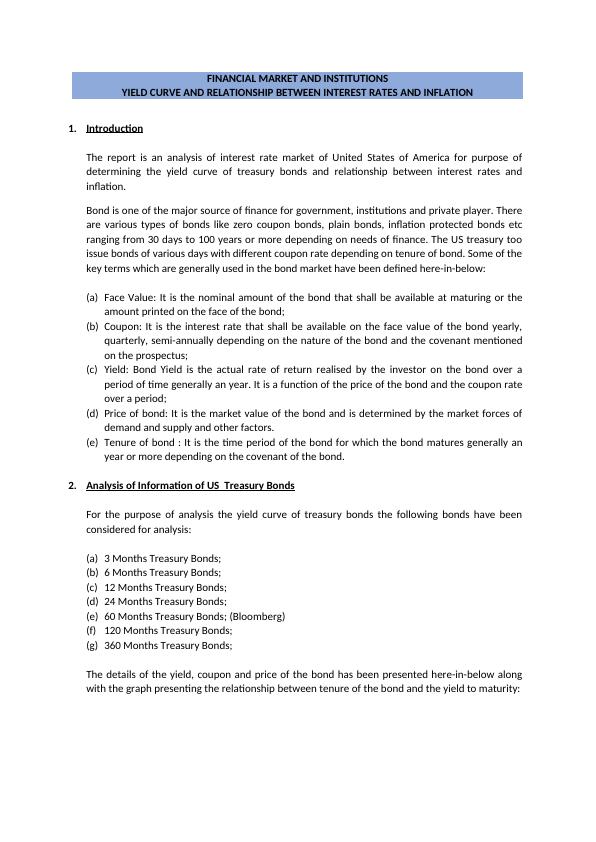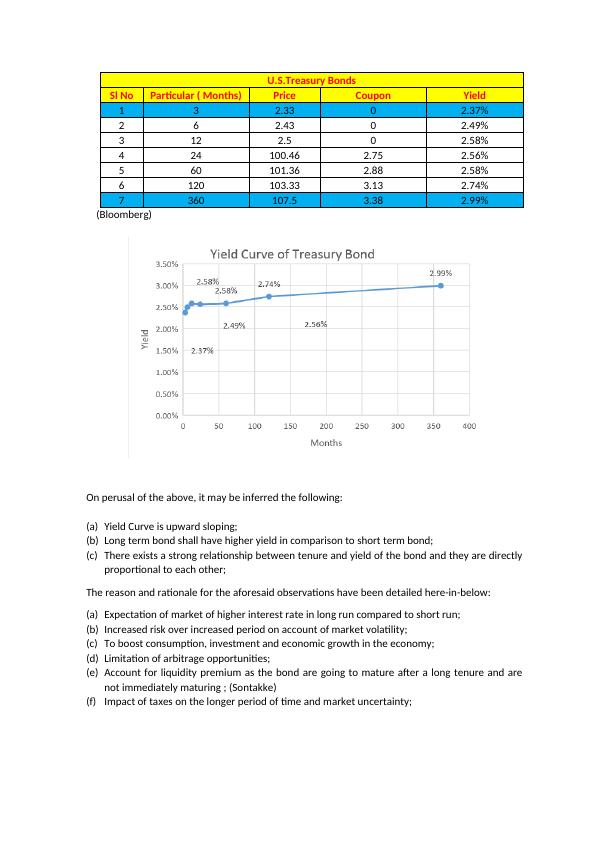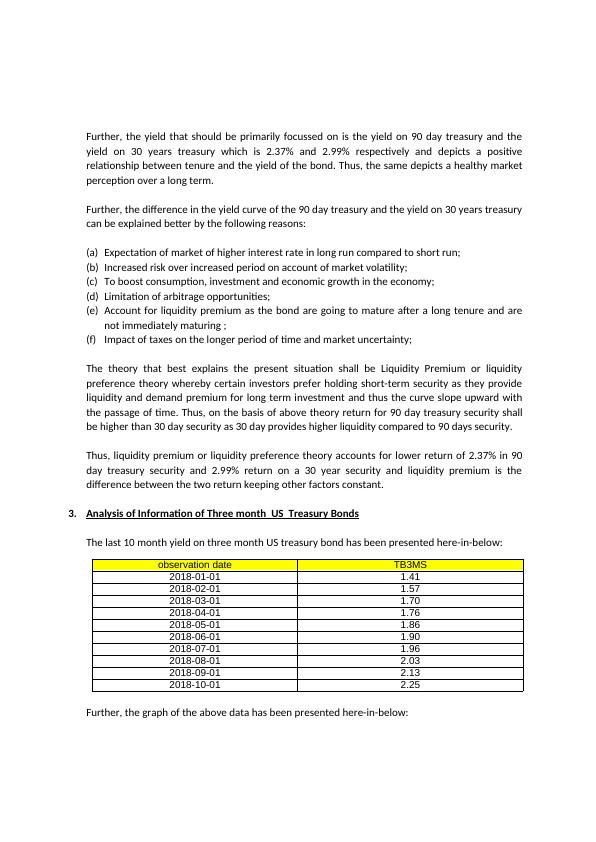Yield Curve and Relationship Between Interest Rates and Inflation
Added on 2023-04-21
8 Pages2008 Words450 Views
FINANCIAL MARKET AND INSTITUTIONS
YIELD CURVE AND RELATIONSHIP BETWEEN INTEREST RATES AND INFLATION
1. Introduction
The report is an analysis of interest rate market of United States of America for purpose of
determining the yield curve of treasury bonds and relationship between interest rates and
inflation.
Bond is one of the major source of finance for government, institutions and private player. There
are various types of bonds like zero coupon bonds, plain bonds, inflation protected bonds etc
ranging from 30 days to 100 years or more depending on needs of finance. The US treasury too
issue bonds of various days with different coupon rate depending on tenure of bond. Some of the
key terms which are generally used in the bond market have been defined here-in-below:
(a) Face Value: It is the nominal amount of the bond that shall be available at maturing or the
amount printed on the face of the bond;
(b) Coupon: It is the interest rate that shall be available on the face value of the bond yearly,
quarterly, semi-annually depending on the nature of the bond and the covenant mentioned
on the prospectus;
(c) Yield: Bond Yield is the actual rate of return realised by the investor on the bond over a
period of time generally an year. It is a function of the price of the bond and the coupon rate
over a period;
(d) Price of bond: It is the market value of the bond and is determined by the market forces of
demand and supply and other factors.
(e) Tenure of bond : It is the time period of the bond for which the bond matures generally an
year or more depending on the covenant of the bond.
2. Analysis of Information of US Treasury Bonds
For the purpose of analysis the yield curve of treasury bonds the following bonds have been
considered for analysis:
(a) 3 Months Treasury Bonds;
(b) 6 Months Treasury Bonds;
(c) 12 Months Treasury Bonds;
(d) 24 Months Treasury Bonds;
(e) 60 Months Treasury Bonds; (Bloomberg)
(f) 120 Months Treasury Bonds;
(g) 360 Months Treasury Bonds;
The details of the yield, coupon and price of the bond has been presented here-in-below along
with the graph presenting the relationship between tenure of the bond and the yield to maturity:
YIELD CURVE AND RELATIONSHIP BETWEEN INTEREST RATES AND INFLATION
1. Introduction
The report is an analysis of interest rate market of United States of America for purpose of
determining the yield curve of treasury bonds and relationship between interest rates and
inflation.
Bond is one of the major source of finance for government, institutions and private player. There
are various types of bonds like zero coupon bonds, plain bonds, inflation protected bonds etc
ranging from 30 days to 100 years or more depending on needs of finance. The US treasury too
issue bonds of various days with different coupon rate depending on tenure of bond. Some of the
key terms which are generally used in the bond market have been defined here-in-below:
(a) Face Value: It is the nominal amount of the bond that shall be available at maturing or the
amount printed on the face of the bond;
(b) Coupon: It is the interest rate that shall be available on the face value of the bond yearly,
quarterly, semi-annually depending on the nature of the bond and the covenant mentioned
on the prospectus;
(c) Yield: Bond Yield is the actual rate of return realised by the investor on the bond over a
period of time generally an year. It is a function of the price of the bond and the coupon rate
over a period;
(d) Price of bond: It is the market value of the bond and is determined by the market forces of
demand and supply and other factors.
(e) Tenure of bond : It is the time period of the bond for which the bond matures generally an
year or more depending on the covenant of the bond.
2. Analysis of Information of US Treasury Bonds
For the purpose of analysis the yield curve of treasury bonds the following bonds have been
considered for analysis:
(a) 3 Months Treasury Bonds;
(b) 6 Months Treasury Bonds;
(c) 12 Months Treasury Bonds;
(d) 24 Months Treasury Bonds;
(e) 60 Months Treasury Bonds; (Bloomberg)
(f) 120 Months Treasury Bonds;
(g) 360 Months Treasury Bonds;
The details of the yield, coupon and price of the bond has been presented here-in-below along
with the graph presenting the relationship between tenure of the bond and the yield to maturity:

U.S.Treasury Bonds
Sl No Particular ( Months) Price Coupon Yield
1 3 2.33 0 2.37%
2 6 2.43 0 2.49%
3 12 2.5 0 2.58%
4 24 100.46 2.75 2.56%
5 60 101.36 2.88 2.58%
6 120 103.33 3.13 2.74%
7 360 107.5 3.38 2.99%
(Bloomberg)
On perusal of the above, it may be inferred the following:
(a) Yield Curve is upward sloping;
(b) Long term bond shall have higher yield in comparison to short term bond;
(c) There exists a strong relationship between tenure and yield of the bond and they are directly
proportional to each other;
The reason and rationale for the aforesaid observations have been detailed here-in-below:
(a) Expectation of market of higher interest rate in long run compared to short run;
(b) Increased risk over increased period on account of market volatility;
(c) To boost consumption, investment and economic growth in the economy;
(d) Limitation of arbitrage opportunities;
(e) Account for liquidity premium as the bond are going to mature after a long tenure and are
not immediately maturing ; (Sontakke)
(f) Impact of taxes on the longer period of time and market uncertainty;
Sl No Particular ( Months) Price Coupon Yield
1 3 2.33 0 2.37%
2 6 2.43 0 2.49%
3 12 2.5 0 2.58%
4 24 100.46 2.75 2.56%
5 60 101.36 2.88 2.58%
6 120 103.33 3.13 2.74%
7 360 107.5 3.38 2.99%
(Bloomberg)
On perusal of the above, it may be inferred the following:
(a) Yield Curve is upward sloping;
(b) Long term bond shall have higher yield in comparison to short term bond;
(c) There exists a strong relationship between tenure and yield of the bond and they are directly
proportional to each other;
The reason and rationale for the aforesaid observations have been detailed here-in-below:
(a) Expectation of market of higher interest rate in long run compared to short run;
(b) Increased risk over increased period on account of market volatility;
(c) To boost consumption, investment and economic growth in the economy;
(d) Limitation of arbitrage opportunities;
(e) Account for liquidity premium as the bond are going to mature after a long tenure and are
not immediately maturing ; (Sontakke)
(f) Impact of taxes on the longer period of time and market uncertainty;

Further, the yield that should be primarily focussed on is the yield on 90 day treasury and the
yield on 30 years treasury which is 2.37% and 2.99% respectively and depicts a positive
relationship between tenure and the yield of the bond. Thus, the same depicts a healthy market
perception over a long term.
Further, the difference in the yield curve of the 90 day treasury and the yield on 30 years treasury
can be explained better by the following reasons:
(a) Expectation of market of higher interest rate in long run compared to short run;
(b) Increased risk over increased period on account of market volatility;
(c) To boost consumption, investment and economic growth in the economy;
(d) Limitation of arbitrage opportunities;
(e) Account for liquidity premium as the bond are going to mature after a long tenure and are
not immediately maturing ;
(f) Impact of taxes on the longer period of time and market uncertainty;
The theory that best explains the present situation shall be Liquidity Premium or liquidity
preference theory whereby certain investors prefer holding short-term security as they provide
liquidity and demand premium for long term investment and thus the curve slope upward with
the passage of time. Thus, on the basis of above theory return for 90 day treasury security shall
be higher than 30 day security as 30 day provides higher liquidity compared to 90 days security.
Thus, liquidity premium or liquidity preference theory accounts for lower return of 2.37% in 90
day treasury security and 2.99% return on a 30 year security and liquidity premium is the
difference between the two return keeping other factors constant.
3. Analysis of Information of Three month US Treasury Bonds
The last 10 month yield on three month US treasury bond has been presented here-in-below:
observation date TB3MS
2018-01-01 1.41
2018-02-01 1.57
2018-03-01 1.70
2018-04-01 1.76
2018-05-01 1.86
2018-06-01 1.90
2018-07-01 1.96
2018-08-01 2.03
2018-09-01 2.13
2018-10-01 2.25
Further, the graph of the above data has been presented here-in-below:
yield on 30 years treasury which is 2.37% and 2.99% respectively and depicts a positive
relationship between tenure and the yield of the bond. Thus, the same depicts a healthy market
perception over a long term.
Further, the difference in the yield curve of the 90 day treasury and the yield on 30 years treasury
can be explained better by the following reasons:
(a) Expectation of market of higher interest rate in long run compared to short run;
(b) Increased risk over increased period on account of market volatility;
(c) To boost consumption, investment and economic growth in the economy;
(d) Limitation of arbitrage opportunities;
(e) Account for liquidity premium as the bond are going to mature after a long tenure and are
not immediately maturing ;
(f) Impact of taxes on the longer period of time and market uncertainty;
The theory that best explains the present situation shall be Liquidity Premium or liquidity
preference theory whereby certain investors prefer holding short-term security as they provide
liquidity and demand premium for long term investment and thus the curve slope upward with
the passage of time. Thus, on the basis of above theory return for 90 day treasury security shall
be higher than 30 day security as 30 day provides higher liquidity compared to 90 days security.
Thus, liquidity premium or liquidity preference theory accounts for lower return of 2.37% in 90
day treasury security and 2.99% return on a 30 year security and liquidity premium is the
difference between the two return keeping other factors constant.
3. Analysis of Information of Three month US Treasury Bonds
The last 10 month yield on three month US treasury bond has been presented here-in-below:
observation date TB3MS
2018-01-01 1.41
2018-02-01 1.57
2018-03-01 1.70
2018-04-01 1.76
2018-05-01 1.86
2018-06-01 1.90
2018-07-01 1.96
2018-08-01 2.03
2018-09-01 2.13
2018-10-01 2.25
Further, the graph of the above data has been presented here-in-below:

End of preview
Want to access all the pages? Upload your documents or become a member.
Related Documents
Desklib Bond Analysis: Yield Curve, Duration, Holding Period Returnlg...
|2
|564
|206
Continually compounded forward rates and zero curves for bondslg...
|22
|4401
|91
Financial Marketslg...
|21
|3096
|420
Fixed Income Securities and Interest Rate Modelling | Assignmentlg...
|8
|342
|16
Fixed Income Securities: Risks and Tools to Decrease Risklg...
|6
|1294
|409
Stochastic Models for Interest Rateslg...
|238
|109574
|59
